Jo and Dawn have actively carried out independent research and scholarship since Tapestry’s founding. We’ve published about what we’ve learned, and we’ve also used what we’ve learned to develop workshops and other learning opportunities for both individuals and organizations. Current work we’re doing may be seen here. This page summarizes a few of the most prominent of these events over the past twenty years.
Online Learning Resources (1998-present)
Since its inception, Tapestry has expended considerable effort in preparing a library of online learning materials about Indigenous ways of knowing, Indigenous Knowledge, and associated topics that help people understand these essential concepts. To date, we have put 111 separate webpages online, accessible through the lists on our Publications and Site Map pages. Together, these copyrighted materials form a book on the subject that is available to the public free of charge. The pages are written to be clear and accessible to as many readers as possible and have been used by a wide range of formal and informal learners.
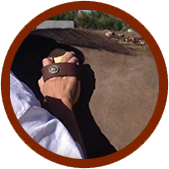 Mindfulness Videos (2018-2019)
Mindfulness Videos (2018-2019)
For about a year, we experimented with producing videos of people and horses, and of the horses themselves, that might be helpful as part of a mindfulness practice session. These were made at a facility in the Colorado Front Range. We posted some of the videos on our Youtube channel, where they still exist. This project helped us begin to understand the elements that need to go into a Virtual Refuge we hope to develop in the next few years. It also helped us realize that it’s essential for the horses to be able to team up with a Land partner again for this to work the way it needs to.
Occasional Papers Series (2015-present)
In 2015, Tapestry began to publish an online series of more academic publications about Indigenous Knowledge. These are written by Tapestry staff or board members.
Horse Ibachakali: healing sessions for The WINGS Foundation of Denver and others (2012-2015)
From 2012 to 2015, Tapestry developed and ran a program called Horse Ibachakali as a program of empowering transformation for the healing of individual human lives. Sessions were offered primarily to adult survivors of childhood sexual assault referred to us by the WINGS Foundation of Denver, though session registration was opened to the general public and we accepted referrals from physicians and therapists across the Colorado Front Range (where we were then located). As one participant said, “It teaches you something about yourself that you didn’t know and you can’t learn in any other way.” One participant, Shawna Ervin, wrote an extraordinary essay about her experience that was published in The Delmarva Review and nominated for a Pushcart Prize. You can read a copy of her essay, which she graciously shared with us, here.
Hardship Hiatus (2008-2012)
A major wildfire burned Tapestry’s ranch facility on Nebraska’s Pine Ridge in 2006 and displaced our programs the following year. In 2007 we lost our lease/purchase on the ranch due to the financial crisis resulting from being unable to operate our programs on the severely burned land (which could not support foot traffic). The following year, 2008, was the year of the beginning of a major national economic downturn. Tapestry’s staff and board slowly lost members to attrition after these events as we struggled to keep our mission alive in very hard times. But in December of 2012, we were finally able to bring our work back into active status once more with projects such as Horse Ibachakali. We are aware of the heavy toll that the economic downturn of 2008 and succeeding years took on non-profits worldwide, and we feel grateful to have kept our mission intact long enough to see a rebirth of our programs. Thank you to everyone who encouraged and supported us through our time of severe trial.
 Voice of the Horse Conference (2007)
Voice of the Horse Conference (2007)
This conference, held in-person at and via live webcast from Iowa State Univeristy in Ames, Iowa, explored some of the current experiences of the horse-human relationship through the use of story. Presenters included Northern Cheyenne trainer Philip Whiteman, Jr.; Chickasaw author Linda Hogan, who was also then a Tapestry board member and a contributor to the Smithsonian’s National Museum of the American Indian volume A Song for the Horse Nation  published at about that time; noted dressage rider and motivational speaker Jane Savoie; wild horse videographer Ginger Kathrens; and the late equine therapy pioneer Marge Kittredge.
published at about that time; noted dressage rider and motivational speaker Jane Savoie; wild horse videographer Ginger Kathrens; and the late equine therapy pioneer Marge Kittredge.
Horse-Human Relationship Survey (2007 and beyond)
Between January and March of 2007, over 1200 people completed a major research survey about the horse-human relationship and the factors that influence it. The survey is being analyzed at this time with the goal of sharing its results in a future publication.
Mythic Living for Modern Women Workshops (2005-2006)
These workshops were designed for small groups of women. Mythic learning was the theme of a curriculum that used all the ways of knowing to better understand the function of mythic ways of learning themselves. Hiking and riding were essential components of the experiential element of the workshop.
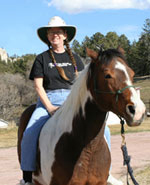 Horse Meditation. (2005, 2008-2012) The first participants in this program were workshop participants who spent time each day riding a horse bareback, while being led so that they did not have to worry about steering the horse. As they did so, they were instructed in a guided meditation that helped them to reconnect with the horse, with the land, and with themselves. It was a powerful experience, and it led one woman, who had a fear of horses for more than 20 years, to no longer be afraid to ride. Since then, Jo Belasco has developed a wider range of horse meditation practices that she’s used in a variety of settings.
Horse Meditation. (2005, 2008-2012) The first participants in this program were workshop participants who spent time each day riding a horse bareback, while being led so that they did not have to worry about steering the horse. As they did so, they were instructed in a guided meditation that helped them to reconnect with the horse, with the land, and with themselves. It was a powerful experience, and it led one woman, who had a fear of horses for more than 20 years, to no longer be afraid to ride. Since then, Jo Belasco has developed a wider range of horse meditation practices that she’s used in a variety of settings.
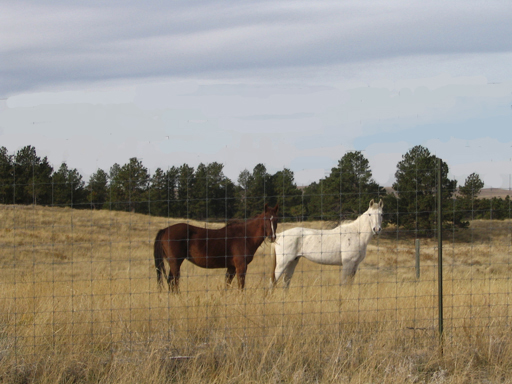 Mustang Freedom Project (2005-2007)
Mustang Freedom Project (2005-2007)
In the fall of 2005, Tapestry received a grant from Keely and Pierce Brosnan to implement the Mustang Freedom Project. Tapestry adopted 3 older Mustangs from the Bureau of Land Management. These Mustangs lived free in a 100-acre pasture on the ranch Tapestry operated out of from 2004-2007. Two of the Mustangs were mares who arrived at the ranch pregnant. One of their foals was born with congenital defects that might have been a consequence of the round-up that brought her mother off the range, but the other survives and now partners in our work.
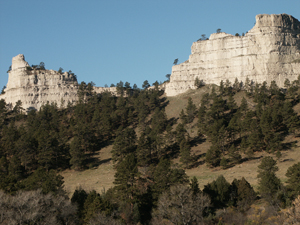 Relocation to a ranch on Northwestern Nebraska’s Pine Ridge (2004-2007)When we realized that all our events worked best when held on sacred land, we realized that we had to relocate to do our work. Specifically, we felt the Land called us to partner more fully with it in a particular Place, and that we needed to search for and find this place. We found Nebraska’s Pine Ridge, and a ranch there, in early December of 2003. We bought it through a lease/purchase agreement and moved there in July of 2004.
Relocation to a ranch on Northwestern Nebraska’s Pine Ridge (2004-2007)When we realized that all our events worked best when held on sacred land, we realized that we had to relocate to do our work. Specifically, we felt the Land called us to partner more fully with it in a particular Place, and that we needed to search for and find this place. We found Nebraska’s Pine Ridge, and a ranch there, in early December of 2003. We bought it through a lease/purchase agreement and moved there in July of 2004.
Digital Library of Indigenous Science Resources, DLISR (2004-2008)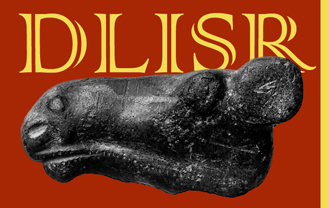
Tapestry Institute partnered with a number of Indigenous organizations worldwide to develop an Indigenous Science digital resource library that would house digital collections of publications, oral recordings, videos, and many other types of traditional wisdom from more than 300 regional and community digital collections assembled by a number of Indigenous cultures. National Science Foundation funding permitted development of a successful prototype, in collaboratioien with DLESE (see below). A major feature of the project involved the cultural and worldview issues impacting search terms and metadata for library access. Unfortunately, at the last moment before the library project was to entire its final step of being fulfilled, the NSF budget line for almost all digital science libraries was zeroed out by a new administration. Without funds, and especially without the “senior” existing digital library that was carrying out the technological part of our process, the project was unable to be completed. The ancient moosehead sculpture on our logo was provided by Indigenous colleagues in Finland through one of our partners, Snowchange.
Digital Library of Earth Systems Education, Partnership and Participation (2003-2005)
Between 2003 and 2005, Tapestry partnered with DLESE at the University of Colorado, in Boulder, Colorado, to help DLESE increase the diversity of both resources in and users of its digital library. Tapestry staff attended DLESE annual workshops and meetings in 2003 and 2004, and prepared several reports in committee. DLESE supported Tapestry’s Digital Library of Indigenous Science Resources (DLISR) for two years after experiencing severe federal funding cuts to their own work.
AAAS and Native Science (2003-2004)
In 2003, faculty from Northwest Indian College organized a special session on Native Science at the annual meeting of the American Association for the Advancement of Science, which was held that year in Denver, Colorado. Tapestry was able to secure 20 registration scholarships to permit Native Scientists from around the country to attend the session and the AAAS meeting in general. Subsequently, an email discussion list was formed and Tapestry organized a 2004 AAAS session on the same subject.
Research on Structural Aspects of Web-Based Learning (2002-2003)
In 2002 and 2003, Tapestry analyzed traffic patterns on the webpages of its primary domains at that time. These were www.tapestryweb.org and stormwind.com (neither of which still exists). Both domains had been developed almost exclusively as educational websites. The stormwind.com site specifically investigated the use of Story in learning, and did so through use of contemporary film and television. The research project of 2002-2003 analyzed the way information on those webpages was accessed to understand how people were learning from the materials. Although some questions we asked were as simple as “what location for a link seems to be most commonly accessed by users?” others were more complex. We had incorporated spatial design elements into the pages, for example, that were keyed to directions in a geo-spatial and spiritual sense, and wanted to see if those were effective. We did not violate user confidentiality in this study but only analyzed the “source page” code for each page view to analyze traffic patterns statistically.
Trailmaster Project: Palo Duro Canyon Event (2003)
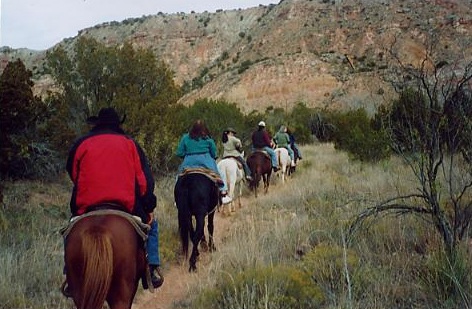 Tapestry Institute held a planning team meeting for a Native Science film in Palo Duro Canyon,Texas, in the early winter of 2003. At this meeting, we planned a trail ride in the canyon as the first planned event. We wanted to see if and how the trail ride impacted the meeting participants with respect to working with each other, to addressing the meeting’s purpose, and to connecting to the land. A brief survey was used to assess the impact of the trail ride on the meeting participants. The results were so positive that they led to the eventual formation of the Horse-Human Relationship Program in order to learn more.
Tapestry Institute held a planning team meeting for a Native Science film in Palo Duro Canyon,Texas, in the early winter of 2003. At this meeting, we planned a trail ride in the canyon as the first planned event. We wanted to see if and how the trail ride impacted the meeting participants with respect to working with each other, to addressing the meeting’s purpose, and to connecting to the land. A brief survey was used to assess the impact of the trail ride on the meeting participants. The results were so positive that they led to the eventual formation of the Horse-Human Relationship Program in order to learn more.
Pre-Production for a Film on Native Science (2001-2003)
While planning the conference “Stories from the Circle,” we also planned a film about Native (Indigenous) Science. Initial planning work was carried out at three meetings, one each in Waco, Texas (2001); Tsaile, Arizona (2002); and Palo Duro Canyon, Texas (2003). With the help of a seed grant from the National Science Foundation, we were able to craft a script and get the project ready for eventual production. However, we were not able to secure production funding to complete the project.
Stories from the Circle: Science and Native Wisdom (1999-2004)
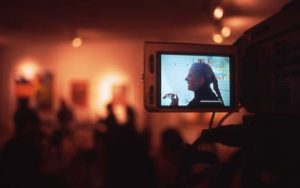 Funded by a grant from the National Science Foundation, the conference was held on the Tsaile campus of Dine College (part of the Tribal College system) near Chinle, Arizona, in May of 2002. Native and non-Native scientists, artists, elders, authors, and many others attended and participated in this seminal conference, which was the first event at which Tapestry specifically included art as a way of learning and knowing.
Funded by a grant from the National Science Foundation, the conference was held on the Tsaile campus of Dine College (part of the Tribal College system) near Chinle, Arizona, in May of 2002. Native and non-Native scientists, artists, elders, authors, and many others attended and participated in this seminal conference, which was the first event at which Tapestry specifically included art as a way of learning and knowing. 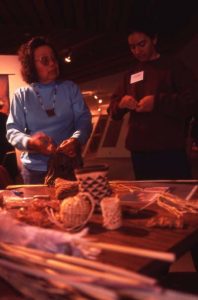 We had a major art show as part of the conference, and also had weaving presentations that developed into impromptu teaching sessions. We prepared a major book manuscript of the conference proceedings and artwork, but even university publishers found it “too non-academic” (they meant “too non-Western”) to consider. We have not yet given up on seeing this important information in print, however. It needs to be shared with others. All the material has been in storage during the decade that Tapestry has had no facility.
We had a major art show as part of the conference, and also had weaving presentations that developed into impromptu teaching sessions. We prepared a major book manuscript of the conference proceedings and artwork, but even university publishers found it “too non-academic” (they meant “too non-Western”) to consider. We have not yet given up on seeing this important information in print, however. It needs to be shared with others. All the material has been in storage during the decade that Tapestry has had no facility.
Research on Identifying the Mythic Structures of Story in Television and Film (2000)
Tapestry’s first work was on understanding mythic ways of knowing and learning through film. In 2000, we designed and carried out a research survey on Story, using a television program. The survey was put online at a major fan site for the program and garnered over 800 responses to a lengthy set of questions, many of which were short essay. Results were explored via contingency table analysis. The surprising but gratifying result was that it seemed possible to identify the type of universal myth being told in the program (story as well as characters, as two separate but related elements) by analyzing what fans responded to and how they responded. An in-house publication was prepared based on this work. A subsequent similar survey on a different program with only one major character and another of a movie (film) with only a single plot structure (“episode”) were both unsuccessful, demonstrating the necessity of a matrix of both characters and episodes in order for the analytical system we’d developed to function.
Southwest Regional Office, Templeton Science and Religion Course Program (1999-2000)
Another area of Tapestry’s early work was understanding spiritual ways of knowing and learning, and their relationships to intellectual ways of knowing and learning. In contemporary culture, this relationship is called “the science and religion issue.” From 1999 to 2000, Dawn Adams (Tapestry’s President and Founder) was the Southwest Regional Director of the then-burgeoning Science and Religion Course Program funded by Sir John Templeton and operated through the Center for Theology and the Natural Sciences in Berkeley, California. In this capacity, Tapestry organized two major (national) conferences on the confluence of science and religion, one in Waco, Texas in 1999 and a second at Grand Canyon College in Phoenix, Arizona in 2000. In addition, Adams traveled extensively to CTNS events as a science-religion faculty member to offer instruction to professors of science, philosophy, and theology at various institutions. She did this in her capacity as both a scientist (doctorate from UCBerkeley) and Native American (Choctaw) who used non-Western approaches to integrating the two disciplines.
Tapestry’s Earliest History
Even before Tapestry was founded, its founder (Dawn Adams) was developing educational methods related to different ways of knowing and learning. While on the faculty of Baylor University, she had received a major grant from the National Science Foundation to revise an introductory biology course for non-majors, and had created a multidisciplinary workgroup of over 20 faculty members from 11 different disciplines and 3 different universities to design the new course. It included art, literature, physical experience, philosophy, and readings from several different religious traditions to illustrate various relationships between religion and science historically. This work grew out of Adams’ Native worldview and led to a number of projects that spanned the time of transition to founding Tapestry, including smaller projects such as making a presentation at the American Indian Science and Engineering Society (AISES) in 1998. This body of work grew throughout Tapestry’s earliest years as a continuation of the theme that had dominated Adams’ professional career in both research and teaching. It has culminated in our present projects.
